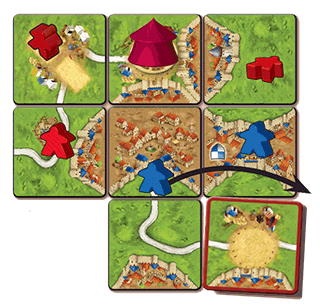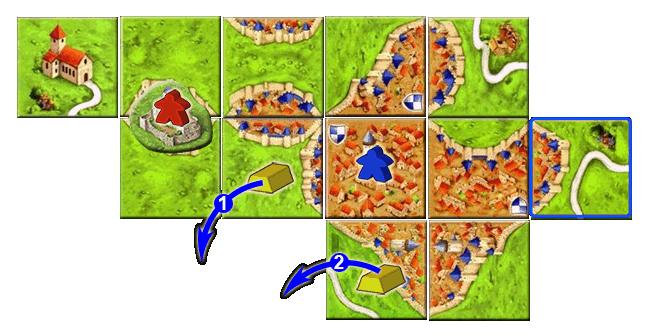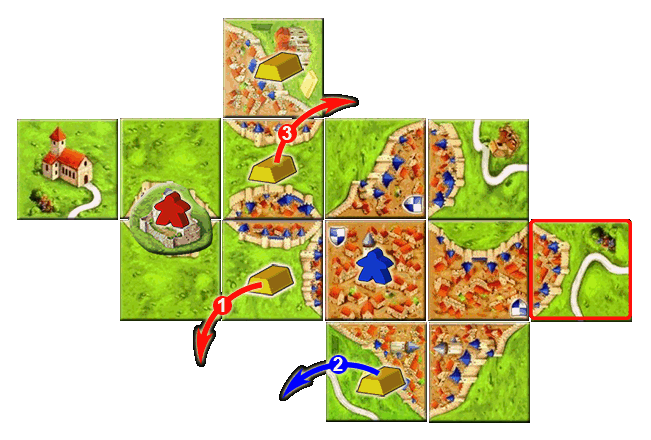Mini Expansion: Goldmines
The most important thing to remember is that the Gold Ingots are placed on
a tile, NOT on a feature!
When you draw a tile with gold on it, place it normally. Then, place one
gold ingot on it, and one gold ingot on an adjacent tile of your choice
(diagonal is allowed). So you always place two gold ingots per tile with
the gold symbol. You may also place a gold ingot on a tile that already
has one or more gold ingots from a previous turn. Gold ingots are not
assigned to specific features. They always apply to all the features on
a tile (see 3. Scoring a feature).
The most important thing to remember is that the Gold Ingots are placed
on a tile, NOT on a feature!
After gold placement, you may still place a meeple according to the
normal rules.
This is where all the confusion comes in!
When you complete a feature with one or more gold ingots on its tiles,
those gold ingots are awarded. The player with the majority in the
completed feature takes all the gold from the corresponding tiles. For
roads and cities, every tile that is part of that road or city is
included; in the case of monasteries, the monastery and each of its 8
surrounding tiles are all included.
In case of a tie: If multiple players share the majority in a completed feature with gold ingots on one or more of its tiles, or if several features with gold ingots are completed at the same time and they are controlled by different players, the distribution is as follows: Starting from the active player, all players take one gold ingot to which they are entitled in clockwise order. This continues until all the gold ingots involved have been taken.
Castles create a special situation: A castle can also take gold ingots, those located in the castle fief. The castle fief has 6 tiles: the two on which the castle was built, the two to the right and the two to the left of it. The castle lord can take gold ingots from them.
 |
Red completes the city occupied by Blue, which triggers the scoring of the castle occupied by Red. As the active player, Red takes a gold ingot first, and then Blue. Blue was also entitled to the gold ingot taken by Red (placed in the castle fief and also on one tile of the city controlled by Blue), but it was Red's only choice in this case. Therefore, Blue can only take the gold ingot at the bottom of the city. |
| Blue completes their city, which triggers the scoring of the castle occupied by Red. As the active player, Blue manages to take both gold ingots. Blue takes the gold ingot in the castle fief first (both Red and Blue were entitled to take it), so Red cannot take any gold ingots. Finally, Blue takes the gold ingot at the bottom of the city. |
 |
 |
Red completes the city occupied by Blue, which triggers the scoring of the castle occupied by Red. There are two gold ingots in the castle fief, one of them placed on a tile of the city controlled by Blue). As the active player, Red decides to take the gold ingot in the castle fief which Blue is also entitled to, so Blue is forced to take the gold ingot at the bottom of the city. Finally, Red takes the other gold ingot in the fief.
Blue gets 1 gold ingot and Red gets 2 gold ingots. |
|